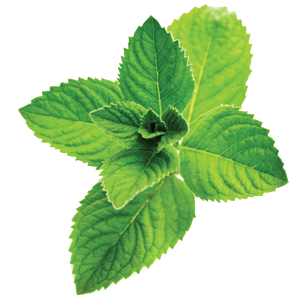|
Spearmint herb or
garden mint or common mint has long been reputed for its characteristic aroma
it imparts to the recipes it added to. The least pungent and subtle among the
species of mint family, this unique herb is one of chef’s main culinary favourites.
Mint herb
botanically belongs to the family of Lamiaceae, of the genus: Mentha.
Scientific name: Mentha spicata.
The plant is a branching perennial herb of Mediterranean origin. It is
widely used across Europe and in large parts of Asia and Africa in flavoured
drinks, salads and confectionary and as a garnish to recipes.
The herb grows
easily in fertile, moist and loose soil with underground runners. In general,
the divisions are planted to propagate. The plant reaches about 75 cm in
height, and bears oppositely arranged leaves all along the thick square stem.
The leaves are deep green, deeply-veined, oval shape with pointed ends and
serrated margins. Slim pointed spikes of mauve flowers appear during late
summer.
There are at
least 20 species of mint and their hybrids exist, most of them difficult to
classify because of their variability and readiness to hybridize among each
other. Here are some mint herbs apart from the popular peppermint and water
mints;
Pineapple mint (M.suaveolens),
Ginger mint (M. x gentilis),
Japanese mint M. arvensis var.piperascens),
Corn mint (M. arvensis),
Bergamot or horsemint (M. Piperita var.citrata).
|
|
Spearmint is
pleasantly aromatic herb packed with numerous health benefiting vitamins,
antioxidants and phyto-nutrients.
The leaves and
herb parts contain essential oil, menthol. Unlike in peppermint, spearmint
leaves composes only small amounts of menthol, 0.5% compared to the 40% in
peppermint. Less menthol content would make this herb least pungent and subtly
fragrant herb in the mint family.
The herb has low
calories (about 43 calories per 100 g) and contains zero cholesterol.
The chief
essential oil in spearmint is menthol. Other important chemical components of
spearmint are α-pinene, β-pinene, carvone, cineole, linalool, limonene, myrcene
and caryophyllene. These compounds in mint help relieve fatigue and stress.
The herb parts
are also very good in minerals like potassium, calcium, manganese, iron (148%
of RDA), and magnesium. Iron is required for enzymes in cellular metabolism and
synthesis of haemoglobin. Potassium is an important component of cell and body
fluids that helps control heart rate and blood pressure. Manganese is used by
the body as a co-factor for the antioxidant enzyme superoxide dismutase.
Further, the herb
is also rich in many antioxidant vitamins, including vitamin A (provides 4054
IU or 135% of RDA), beta-carotene, vitamin C, folates (26% of RDA), vitamin B-6
(pyridoxine), riboflavin and thiamin.
Antibacterial
Capacity: The most common association of spearmint is
with fresh breath, but its role in mouthwashes and toothpastes are not solely
to keep your breath smelling good. The natural antibacterial and antimicrobial nature
of menthol and other organic compounds in spearmint can help to protect your
mouth and throat from infections, including those that can damage dental and
gum health. Furthermore, bad breath is actually called halitosis, which is
caused by bacteria below the gums, so spearmint keeps you healthy and smelling
great!
Respiratory Health: Staying in the same region of the body, spearmint tea has a
significant impact on the health of your respiratory system due to its
naturally soothing and anti-inflammatory qualities. It can help to relieve sore
throats and tightness in the chest, alleviating congestion and irritation.
Spearmint’s powerful aroma can also help to clear up sinuses and even increase
mental clarity, according to certain experts.
Digestion: Spearmint has a number of roles to play in the digestive system,
particularly as a gentle tonic to ease upset stomachs. It is popular during
pregnancy to prevent morning sickness, nausea, and vomiting, but can also be
used by others suffering from such gastrointestinal issues as excess
flatulence, cramping, or bloating. IBS (Irritable Bowel Syndrome) seems to be
increasing in recent years, and spearmint tea or chewing directly on spearmint
leaves is often recommended to treat or manage that condition more effectively.
Hormonal Balance: For those suffering from polycystic ovary syndrome or some other
form of hormonal imbalance, spearmint has been shown to help manage or treat
the condition. The powerful organic compounds in spearmint can inhibit and
stimulate the endocrine system in different ways, helping to optimize your
hormonal balance and preventing the complicated metabolic side effects,
including hirsutism, by reducing excessive testosterone levels in females.
Circulation: The iron content in a single serving of spearmint is more than
100% of the daily recommended amount, which can stimulate the production of red
blood cells and haemoglobin. This not only prevents anaemia, but also increases
circulation to the body’s extremities, boosting energy levels and wound
healing.
Heart Health: The high potassium levels found in spearmint are crucial to
maintaining healthy blood pressure; potassium is a vasodilator, meaning that it
relieves the stress on blood vessels and arteries, therefore helping to prevent
atherosclerosis, strokes, and heart attacks.
Stress Relief: Menthol, one of the most powerful active ingredients in
spearmint, has a soothing, almost sedative effect on the body, which has been
known to produce a calm, relaxed state. If you suffer from chronic stress or
anxiety, a cup of spearmint tea can help to ease your mind and eliminate the
negative effects of chronic stress hormones on your body’s systems.
Chronic Disease: Some of the other chemical compounds found in spearmint
include limonene, cineole, pinene, vitamin A, vitamin C, riboflavin, and
thiamin. The combination of antioxidant compounds with metabolism-balancing
substances makes spearmint a powerful tool to prevent chronic diseases,
including cancer, many of which are caused by free radicals attacking healthy
cells. Antioxidants neutralize these free radicals and eliminate them from the
body.
|

